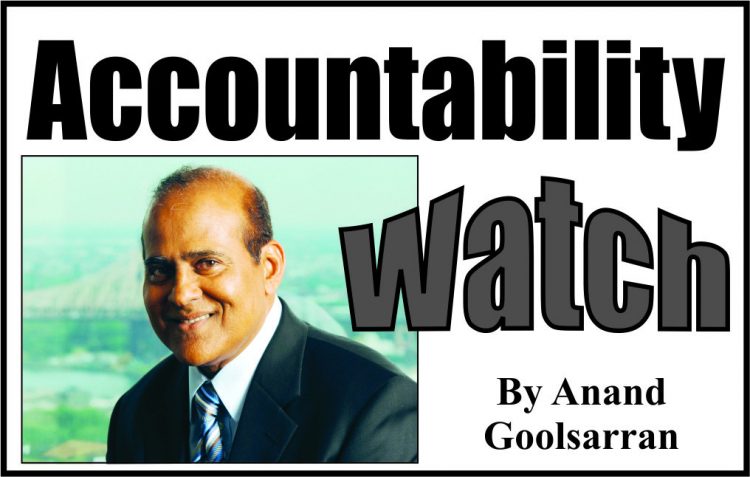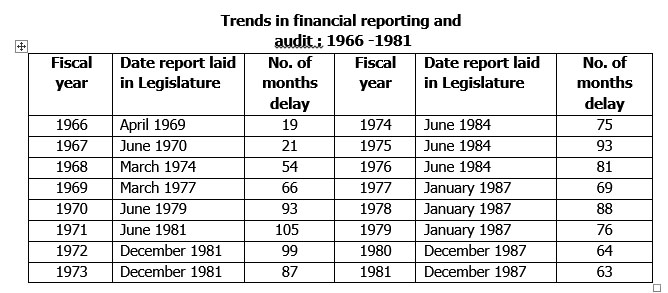
The Auditor General presented his 2018 report to the Speaker of the Assembly on 30 September 2019. The report is yet to be laid in the Assembly. His report for 2019 was due for submission on 30 September 2020. However, in view of the COVID-19 pandemic measures taken by the Government, the Audit Office has been unable to complete its audits of Ministries, Departments and Regions in time for the finalization of the Auditor General’ report.
Today’s article is a continuation of last week’s and focuses on my reflections on the state of public accountability during the period I served as Auditor General. In doing so, I also offer my recollections of the work of the PAC. The Auditor General is the principal advisor to the PAC.
Public accountability at the beginning of 1991
At the time I took up office in September 1990, public accountability had ground to a halt, with the last set of audited accounts to be produced being in respect of 1981. The official explanation given for the failure produce accounts for subsequent years was that the main frame IBM 3/15 computer at the central Ministry of Finance, that was used to process the Government’s financial transactions, had “crashed”. It was therefore not possible to extract account balances in order to prepare the public accounts.
Given that situation, I suggested that the accounts could be reconstructed using the decentralized accounting records of Ministries and Departments but this did not find favour with the officials of the Ministry of Finance. I then offered the following proposal. Let us take a concurrent two-pronged approach to bring the accounts up-to-date. The first was to draw a line between the years 1990 and 1991 and put controls in place to enable the timely extraction of transactions and balances in order to prepare the public accounts for 1991 onwards. At the same time, we assemble a task force comprising, say, three officials, to reconstruct the accounts for the backlogged years 1982-1990. The rationale for advocating this approach was that based on historical trends it would take roughly five years to produce audited public accounts for any one year so that by the time we would have completed 1990, there would still be five years of backlogged accounts to deal with. In this way, we would never be able to have up-to-date audited public accounts.
Table I shows the trend in financial reporting and audit of the public accounts for the period 1966 to 1981:

The then Minister of Finance agreed to my proposals for resumption of financial reporting and audit of the public accounts when I presented them to him. However, senior officials of the Ministry vigorously opposed the proposals on the grounds that it was unprecedented to have audited accounts for later years without first completing earlier years i.e. everything must be done sequentially and that in any event opening balances were needed. I countered by stating that of the hundreds of accounts that comprised the public accounts of which very few required opening balances could in any event be estimated until the backlogged accounts were finalized.
The print media assisted me in advocating for my approach to the restoration of public accountability. At the same time, I announced my intention to audit the Government’s privatization programme, amid allegations that it was being executed in a hasty and non-transparent manner. My public utterances invoked the wrath of then government and I was promptly summoned to the Office of the President to explain myself. My defence was that I was frustrated in that since my appointment, nothing had happened at the Ministry of Finance to advance the process of public accountability and specifically to have the public accounts prepared and submitted to me for audit examination. The then President Hoyte responded by stating that (i) we were all in the same boat; (ii) he was having his own difficulties; (iii) the Ministry of Finance could not produce the public accounts unless instructed to do so; and (iv) the Minister of Finance would be writing me in connection with my attempts to audit the Government’s privatization programme.
Restoration of public accountability
Following the 1992 elections, I renewed my advocacy for the restoration of public accountability based on the two-prong approach referred to above. The new Administration was very receptive to my proposals, and I was invited to a meeting with then Head of the Presidential Secretariat (HPS) Dr. Roger Luncheon and the Accountant General. I laid out the rationale for my advocacy while the Accountant General, for his part, presented his grounds for objection. The latter’s main argument was that if the Government were to accept my proposals, the public accounts would be highly flawed in that it would reflect a high degree of inaccuracy. The HPS then enquired of the Accountant General as to the level of inaccuracy that would be achieved if my proposals were to be followed. To this, the Accountant General responded by stating that such accuracy would be in the vicinity of 60-70 percent. The HPS then asked: Is 60-70 percent level of accuracy not better than not having any public accounts at all? The Accountant General fell silent!
Within days, instructions were issued to the officials of the Ministry of Finance and all accounting officers to comply with my request to prepare financial statements relating to the public accounts or 1992 and to submit them to my office for audit examination and reporting to Parliament. There was, however, still some degree of resistance, and the Audit Office had to lead the effort without compromising on its independence, including taking the draft submissions, reworking them to an acceptable format using a personal computer that I had bought while attending a six-month training programme with the U.S. Government Accountability Office. The Audit Office, under my guidance, duly audited the public accounts for 1992. I then submitted my report to the then acting Minister of Finance, the late Shree Chand, within the statutory deadline on 30 September 1993.
Re-activation of the PAC
With the restoration of public accountability, the newly constituted PAC began its examination of the public accounts for 1992 shortly thereafter. However, because the report was extremely critical of the Government’s management of the country’s finances, the PAC vigorously sought to challenge the legality and validity of the accounts on which the report was based, on the grounds that: (i) the accounts had to be presented as a whole and the omission of two important statements rendered them invalid; and (ii) it was unprecedented to have financial reporting for a later year without the earlier years being reported on first.
The Chairmanship of the PAC was held by a senior Minister of the then previous Administration, the late Dr. Kenneth King. The reality was that he was chairing a committee that was examining the Auditor General’s report covering a substantial part of the fiscal year 1992, for which his party was in government. Regrettably, political expediency took precedence over the broader interest in that the Opposition members of the Committee took an extremely defensive position and vigorously sought to discredit my report. Instead of the Accountant General and accounting officers being asked to explain the deficiencies identified in the report, they were encouraged, indeed prodded, to disagree with my findings. I was in effect placed on trial for advocating for the restoration of public accountability and for reporting on the state of affairs as I saw it based on professional training and experience; and for having at heart the public interest above all other interest.
The following section of 1992 PAC report captures the essence of what transpired:
However, because of the apparent inadequacy of the statements provided him by the Accountant General and the Debt Management Unit, the Auditor General was unable to determine the true nature of the Public Debt of Guyana… the Auditor General was unable to verify the statement of outstanding loans or credits that had been guaranteed by the government, and the statement of outstanding loans and advances that had been made from the Consolidated Fund. On top of all of this, the Auditor General could not deter mine also what balances on deposit, at the end of 1992, were held by the Accountant General and what outstanding advances had been made. He could not even certify the current assets and liabilities of the Government.
Despite these criticisms, and a fundamental lack of understanding of the audit process and the role of the external auditor, in particular the Auditor General, the effort was a landmark achievement, ushering in a new era in public accountability in Guyana. My reports for the fiscal years 1993 and 1994 were also presented to the Minister within the statutory deadline. In terms of content, they were as critical as that of 1992, especially with regard to the failure of the Government to submit two important statements. The 1993 PAC report, which was also finalized in the same month as that for 1992, took a dramatic change in tone:
The Committee commends the Auditor General and his staff for preparing a report on the several statements and accounts submitted to their office. The Committee notes with approval that, because of the omission of two statements, the Auditor General has properly qualified the accounts and statements which the Minister of Finance has laid in Parliament. The Committee emphasizes most strongly that it does not wish to discourage the Auditor General from presenting and commenting on the reports that are made available to him. It urges, however, that it be always made clear that the reports do not represent the public accounts in their entirety, and that those accounts and reports are of crucial importance.
With a change in chairmanship of the PAC, the Committee set aside partisan political interests, and was genuinely seen to be functioning in the national interest. At the conclusion of the PAC examination of the 1994 accounts, I was requested to draft the PAC report, as was the practice for the years prior to 1981. This report was laid in the National Assembly in March 2000. Through the continuous efforts of the Audit Office to influence the Accountant General’s Department to prepare and submit the two outstanding statements, it was not until 1996 and 1999 that they were eventually included in the public accounts. Complete and full financial reporting was therefore not achieved until seven years after the resumption of financial reporting.
To be continued –




